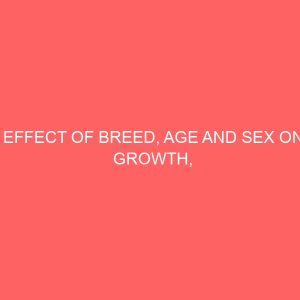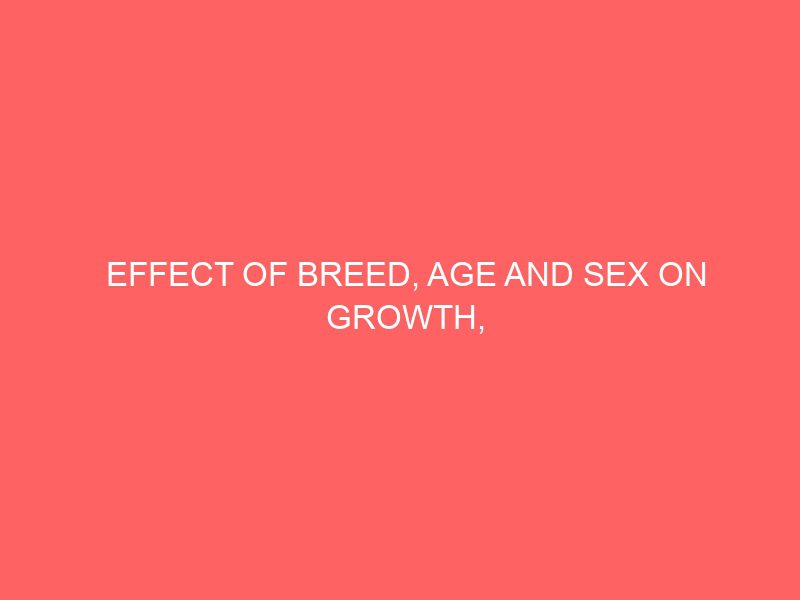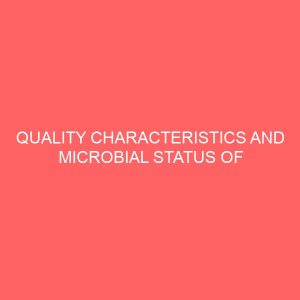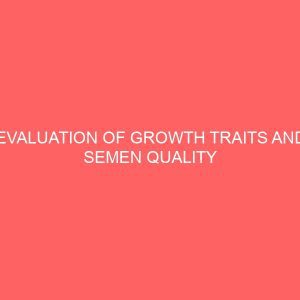Description
ABSTRACT
A study was conducted to assess the effect of breed, sex and age on growth, haematological, serum biochemical and carcass characteristics of Turkey. The data was generated from 100 Turkeys which comprised 50 Norfolk breed and 50 Mammoth breed. The growth traits included biweekly body weight (BW) and linear body measurements: neck length (NL), body length (BL), thigh length (TL), shank length (SL), chest girth (CG) and wing length (WL). Haematological parameters included packed cell volume (PCV), haemoglobin (Hb), pH, red blood cells (RBC) and white blood cells (WBC). Biochemical parameters included total protein (Tp), aspartate transaminase (AST), alanine transaminase (ALT) and creatinine and all the carcass traits (live weight, dressed weight, carcass weight, thigh, breast, wing, back, drumstick and neck). The results obtained for body weight at 20 weeks were 4.15kg and 2.80kg, respectively for male and female Norfolk while for Mammoth were 3.70kg and 3.02kg for male and female, from the result it shows that the male of Norfolk have significantly (P<0 .05="" all="" are="" body="" but="" bw="" different="" female="" for="" have="" higher="" in="" linear="" male="" mammoth="" measured="" measurements="" no="" norfolk.="" norfolk="" of="" parameters="" result="" shows="" significant="" significantly="" than="" that="" the="" values="" which="">0.05) difference were observed in all the parameters measured between the females except for BL where the Mammoth female have significantly (P<0 .05="" between="" breeds="" but="" difference="" haematological="" higher="" no="" norfolk.="" of="" parameters="" result="" shows="" significant="" significantly="" than="" that="" the="" there="" value="" were="">0.05) difference between sex within breed with Mammoth having the best values in all the parameters measured except for WBC, where the Norfolk have the best values. For biochemical parameters it shows that there were significant (P<0 .05="" alt="" and="" between="" breed="" but="" difference="" in="" no="" significant="" the="" tp="" values="">0.05) different between sex within breed. AST and Creatinine have no significant (P>0.05) difference between and within the breed. The result of carcass shows that there were significant (P<0 .05="" all="" and="" between="" breed="" difference="" except="" has="" in="" measured="" no="" significance="" the="" thigh="" traits="" which="" within="">.05) difference by the breed and sex. For the organs Norfolk also have the higher values. The result for correlations shows highly positive correlation and high significant (p<0 .01="" all="" and="" are="" because="" better="" between="" body="" breast="" breed="" conclusion="" correlated="" correlations="" drumstick="" farmers="" fast="" for="" go="" growth="" has="" high="" highly="" in="" is="" it="" low="" mammoth="" measured="" moderate="" neck="" norfolk.="" norfolk="" other="" positive="" positively="" should="" so="" span="" that="" the="" thigh="" to="" traits.="" traits="" was="" weight="" were="" while="" with="">
CHAPTER ONE
1.0 INTRODUCTION
Turkey (Meleagris gallopavo) is a source of animal protein and one of the world‘s most demanded poultry. And it‘s meat consumed in large quantities in Nigeria. Despite the increase in demand for turkey consumption, there are no large scale commercial turkey farms in Nigeria to meet the ever increasing demand (Ogah, 2011). Turkey breeders have selected birds for fast growth and large body size in order to maximize production (Kranis et al.,2008).
Turkey has been found to contribute to the economic and social life of Nigerians in that they are used during festive periods (Smith, 1990). Growth is defined as the increase in the numbers of cell of the body. Growth performance of an animal is the phenotypic expression of the animal genetic makeup (genotype), (Oluyemi and Roberts, 2000). The exact time at which the animal is ready for slaughter can be consider on the basis of body weight and general development (Kabir et al., 2006).
Nowadays with the vast majority of poultry products being marketed in cut-up parts, yield of high value items such as breast and thigh have become critical to processors (Young et al., 2001). Watts and Kennett (1995) reported that demand for high quality parts have driven poultry industry to change their marketing practices to cut-up parts in response to consumer‘s needs.
Linear body measurements are useful in live weight determination (Gul et al., 2005). The relationships existing among linear body traits provide useful information on performance, productivity and carcass characteristics (Kabir et al., 2010).







